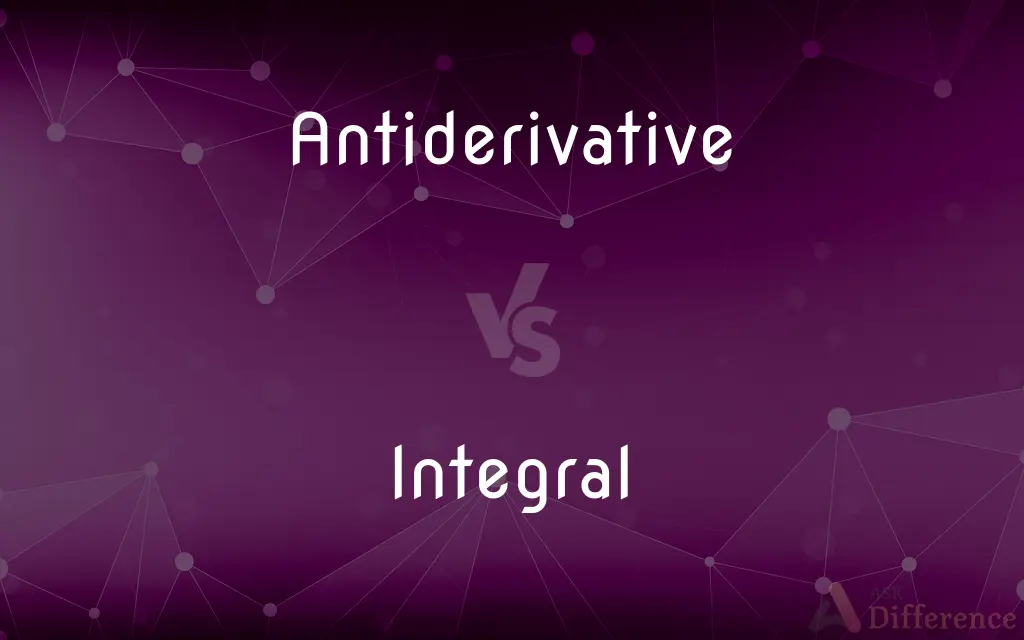Antiderivative vs. Integral — What's the Difference?
By Tayyaba Rehman & Urooj Arif — Updated on April 3, 2024
Antiderivative refers to a function obtained from the original by reversing differentiation, while integral calculates the area under a curve or accumulation.

Difference Between Antiderivative and Integral
Table of Contents
ADVERTISEMENT
Key Differences
The antiderivative, also known as an indefinite integral, represents the inverse process of differentiation. If F is an antiderivative of f, then the derivative of F is f. This concept focuses on finding a function that, when differentiated, returns the original function. Integrals, on the other hand, include both definite and indefinite integrals, where the indefinite integral is synonymous with the antiderivative, and the definite integral calculates the area under a curve or accumulation of quantities.
When discussing the antiderivative, the focus is primarily on the relationship between functions in terms of differentiation and integration. For example, the antiderivative of 2x is x2 +C, where C is the constant of integration indicating an infinite number of antiderivatives. Whereas, the integral extends this concept to calculate quantities such as areas, volumes, and other accumulations. The definite integral of 2x from a to b calculates the area under the curve y=2x from x=a to x=b.
Antiderivatives are crucial in solving differential equations, where the goal is to find a function that satisfies a given derivative relationship. This process is foundational in many areas of mathematics and physics. Integrals, encompassing both definite and indefinite, are used in a wider range of applications, including calculating distances, areas, volumes, and other physical quantities from rates of change or density functions.
Understanding the difference between antiderivatives and integrals is crucial in fields such as physics, engineering, and economics, where these concepts are applied to model and solve real-world problems. While the antiderivative focuses on reversing differentiation, the integral—especially the definite integral—applies this principle to compute specific quantities based on the function's graph.
Comparison Chart
Definition
Function obtained by reversing differentiation.
Calculation of area under a curve or accumulation.
ADVERTISEMENT
Includes
Indefinite integrals.
Both definite and indefinite integrals.
Focus
Finding a function that returns the original when differentiated.
Calculating areas, volumes, and accumulations.
Applications
Solving differential equations.
Wide range, including physics and engineering tasks.
Compare with Definitions
Antiderivative
Focuses on function relationship.
Finding the antiderivative is crucial in solving differential equations.
Integral
Includes both definite and indefinite forms.
Integrals are versatile in application, from calculating physical quantities to solving equations.
Antiderivative
Inverse of differentiation.
The antiderivative of 2x is x2 +C.
Integral
Applied in various fields.
Integrals are used in physics to calculate work done by a force over a distance.
Antiderivative
Essential in calculus.
Antiderivatives are foundational for understanding the behavior of functions over intervals.
Integral
Calculates areas and accumulations.
The definite integral of 2x from 0 to 2 calculates the area under the curve.
Antiderivative
Basis for indefinite integrals.
The antiderivative represents the general form of integration without bounds.
Integral
Indispensable in mathematical analysis.
Integral calculus is a key tool for analyzing and interpreting continuous functions.
Antiderivative
Includes the constant of integration C.
All antiderivatives of cos(x) include +C.
Integral
In mathematics, an integral assigns numbers to functions in a way that describes displacement, area, volume, and other concepts that arise by combining infinitesimal data. The process of finding integrals is called integration.
Antiderivative
In calculus, an antiderivative, inverse derivative, primitive function, primitive integral or indefinite integral of a function f is a differentiable function F whose derivative is equal to the original function f. This can be stated symbolically as F' = f.
Integral
Necessary to make a whole complete; essential or fundamental
Games are an integral part of the school's curriculum
Systematic training should be integral to library management
Antiderivative
See indefinite integral.
Integral
Of or denoted by an integer.
Antiderivative
(calculus) A function whose derivative is a given function; an indefinite integral Category:en:Functions
Integral
A function of which a given function is the derivative, i.e. which yields that function when differentiated, and which may express the area under the curve of a graph of the function.
Integral
Essential or necessary for completeness; constituent
The kitchen is an integral part of a house.
Integral
Possessing everything essential; entire.
Integral
Expressed or expressible as or in terms of integers.
Integral
Expressed as or involving integrals.
Integral
A complete unit; a whole.
Integral
A number computed by a limiting process in which the domain of a function, often an interval or planar region, is divided into arbitrarily small units, the value of the function at a point in each unit is multiplied by the linear or areal measurement of that unit, and all such products are summed.
Integral
A definite integral.
Integral
An indefinite integral.
Integral
Constituting a whole together with other parts or factors; not omittable or removable
Integral
(mathematics) Of, pertaining to, or being an integer.
Integral
(mathematics) Relating to integration.
Integral
(obsolete) Whole; undamaged.
Integral
(mathematics) One of the two fundamental operations of calculus (the other being differentiation), whereby a function's displacement, area, volume, or other qualities arising from the study of infinitesimal change are quantified, usually defined as a limiting process on a sequence of partial sums. Denoted using a long s: ∫, or a variant thereof.
The integral of a univariate real-valued function is the area under its curve; but be warned! Not all functions are integrable!
Integral
(specifically) Any of several analytic formalizations of this operation: the Riemann integral, the Lebesgue integral, etc.
Integral
(mathematics) A definite integral: the result of the application of such an operation onto a function and a suitable subset of the function's domain: either a number or positive or negative infinity. In the former case, the integral is said to be finite or to converge; in the latter, the integral is said to diverge. In notation, the domain of integration is indicated either below the sign, or, if it is an interval, with its endpoints as sub- and super-scripts, and the function being integrated forming part of the integrand (or, generally, differential form) appearing in front of the integral sign.
The integral of on is , but the integral of the same function on diverges. In notation, , but .
Integral
(mathematics) An indefinite integral: the result of the application of such an operation onto a function together with an indefinite domain, yielding a function; a function's antiderivative;
The integral of is plus a constant.
Integral
The fluent of a given fluxion in Newtonian calculus.
Integral
Lacking nothing of completeness; complete; perfect; uninjured; whole; entire.
A local motion keepeth bodies integral.
Integral
Essential to completeness; constituent, as a part; pertaining to, or serving to form, an integer; integrant.
Ceasing to do evil, and doing good, are the two great integral parts that complete this duty.
Integral
Of, pertaining to, or being, a whole number or undivided quantity; not fractional.
Integral
A whole; an entire thing; a whole number; an individual.
Integral
An expression which, being differentiated, will produce a given differential. See differential Differential, and Integration. Cf. Fluent.
Integral
The result of a mathematical integration; F(x) is the integral of f(x) if dF/dx = f(x)
Integral
Existing as an essential constituent or characteristic;
The Ptolemaic system with its built-in concept of periodicity
A constitutional inability to tell the truth
Integral
Constituting the undiminished entirety; lacking nothing essential especially not damaged;
A local motion keepeth bodies integral
Was able to keep the collection entire during his lifetime
Fought to keep the union intact
Common Curiosities
Why do we add a constant C to antiderivatives?
The constant C accounts for the fact that there are infinitely many functions that can serve as antiderivatives, differing only by a constant.
What is an antiderivative used for?
An antiderivative is used to find a function whose derivative is the given function, essential in solving differential equations and understanding function behavior.
How does an integral differ from an antiderivative?
An integral, encompassing both definite and indefinite forms, calculates areas under curves and accumulations, whereas an antiderivative focuses on reversing the process of differentiation.
What is the significance of definite integrals?
Definite integrals are significant for calculating precise quantities like areas, volumes, and other accumulations, crucial in various scientific and engineering applications.
How do you find an antiderivative?
Finding an antiderivative involves knowing the basic derivatives and applying the rules of integration, often requiring manipulation of the function to match a known form.
Can all functions have antiderivatives?
Most elementary functions have antiderivatives, but some functions, especially those not continuous everywhere, may not have antiderivatives expressible in terms of elementary functions.
How are integrals used in real life?
Integrals are used to model and solve problems related to rates of change, area and volume calculations, economics, physics problems like motion and energy, and engineering design.
Can the concept of integration be applied to discrete functions?
While integration is primarily for continuous functions, discrete analogs, like summations, serve a similar purpose in accumulating quantities over discrete intervals.
Are antiderivatives and indefinite integrals the same?
Yes, antiderivatives and indefinite integrals are essentially the same, both representing the general solution to the process of differentiation.
What is a practical example of using a definite integral?
A practical example includes calculating the total distance traveled by an object when given its velocity over time, using the definite integral to sum up all infinitesimal distances.
Share Your Discovery

Previous Comparison
Carryall vs. Truck
Next Comparison
Novel vs. UniqueAuthor Spotlight
Written by
Tayyaba RehmanTayyaba Rehman is a distinguished writer, currently serving as a primary contributor to askdifference.com. As a researcher in semantics and etymology, Tayyaba's passion for the complexity of languages and their distinctions has found a perfect home on the platform. Tayyaba delves into the intricacies of language, distinguishing between commonly confused words and phrases, thereby providing clarity for readers worldwide.
Co-written by
Urooj ArifUrooj is a skilled content writer at Ask Difference, known for her exceptional ability to simplify complex topics into engaging and informative content. With a passion for research and a flair for clear, concise writing, she consistently delivers articles that resonate with our diverse audience.














































